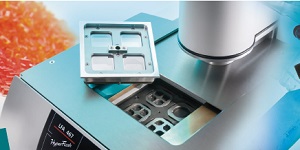The Flash method is a fast, non-contact, and efficient method for measuring the three fundamental thermophysical properties of thermal diffusivity, specific heat capacity, and thermal conductivity. A new Light Flash Apparatus, the LFA 467 HyperFlash from Netzsch, pushes the boundaries in measuring these properties.

With a single instrument setup – that is, without having to swap out either the detector or the furnace – the LFA 467 can carry out measurements from -100°C to 500°C. Coupled with the broadest range of accessories available on the market, the instrument opens the door to completely new dimensions in the determination of thermophysical properties.
One unique advantage of the LFA 467 is its ability to simultaneously measure up to 16 samples over the entire temperature range. This allows for maximum sample throughput with a minimum input of operational time and effort. Refill systems are available for automatic refilling of the Dewar on both the detector and the furnace, allowing uninterrupted operation of the LFA system around the clock.
The patent-pending ZoomOptics system optimizes the field of view of the detector, thus eliminating any influences caused by aperture stops. The result is a significant increase in the precision of the measurement results.
Thin films and high-conductivity materials require a very high data acquisition rate for the precise recording of rapid temperature increases on a sample’s upper surface. The LFA 467 offers a sampling rate of 2 MHz – an unprecedented value for commercial LFA systems.